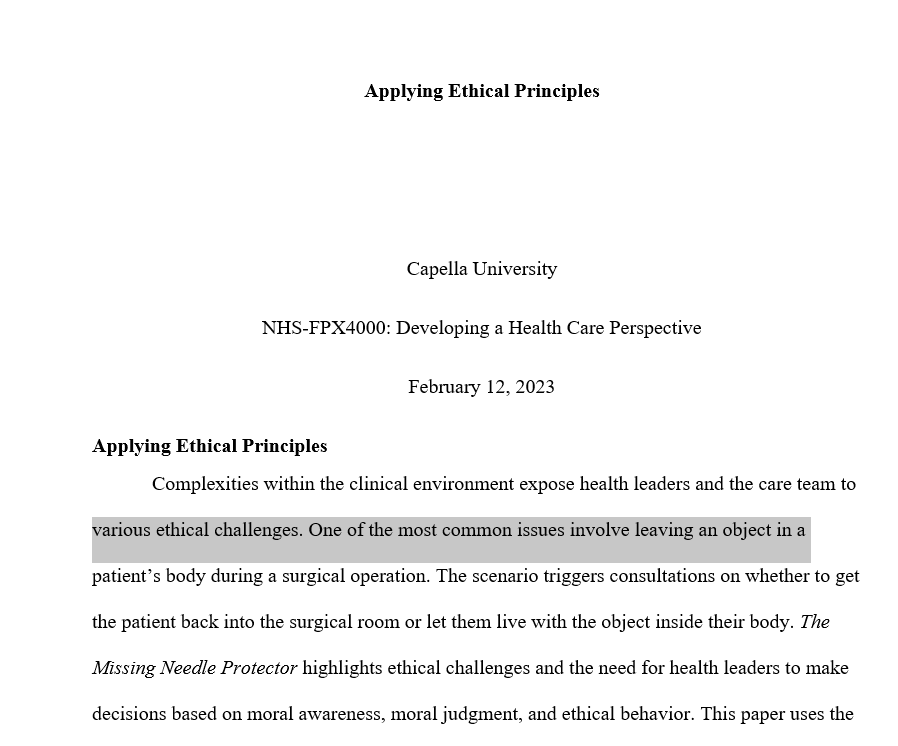Capella University
NHS4000 Developing a Healthcare Perspective
Dr. Michelle Rose
January 9, 2024
Applying Ethical Principles
The concept of “ethics” emerged from the Ancient Greece over 2000 years ago. Socrates along with a set of teachers from Athens, called “The Sophists”, were among the pioneering moral philosophers in the Western Civilization. Foundationally, being ethical meant that one did not intentionally do harm to another. Ethics further spun into the examination of wrong or right behavior, and focused on deeper concepts such as justice, virtue and, duty. Ethics on a personal level determines how each individual views morality and inevitably, is the driving force of what motivates them to make a final decision in certain circumstances called ethical dilemmas. The following analysis of a case study # 9 (The Missing Needle Protector), will explore this concept in further details. Evidence-based and patient-centered surgical care requires healthcare professionals to avoid leaving objects in a patient’s body. The case describes one of the multiple dilemmas that have reputational and financial implications for an organization.
Overview of the Case: The Missing Needle Protector
In an operation rooms, the operating team completes a checklist of medical tools and supplies before and after the procedure. This exercise ensures that the team does not leave medical tools or equipment in a patient’s body. In the Missing Needle Protector, Dr. Cutrite, a long-standing surgeon at Hopewell Hospital, had been facing deterioration in his skill levels and competency due to his age. Colleagues and the Director or Clinical Services are aware of the situation. One day, Dr. Cutrite performed a surgery on a patient, and during the count for the tools used, they realized there was a missing needle protector. The Operating Room supervisor reported the possibility of the needle cap remaining in the patient’s abdomen but was not concretely sure. The questions now emerged as to whether or not they should reopen the patient in order, to look for this missing needle cap, under the disguise that: “We’ll tell her it’s necessary to check her incision and deep sutures. She will never know we’re really looking for the needle cover.” (Case Study #9). They further hypothetically presented the concern to another fellow surgeon, asking whether a patient could face life threatening harm from the needle cap remaining in her body.
The scenario highlights one of the serious safety gaps that could jeopardize an organization’s reputation. The fact that the surgical team left a needle protector in the patient’s body raises concerns about the safety culture and staff adherence to policies, procedures, and standards meant to enhance the quality of care. The argument was that the needle protector was undetectable since its color resembled blood. The director of clinical services understood the implication of the issue and the need for a comprehensive response. The awareness led to Straight considering getting the patient back to the facility for a procedure to remove the needle protector. According to Kadivar et al. (2017), healthcare professionals should enhance vigilance when handling patients in complex environments. The care team should understand their individual and collective responsibilities, including the ability to make informed decisions when faced with ethical dilemmas. The case also captured the need for organizations to fulfill the principles of beneficence and non-maleficence that advocate for a patient’s best interests and protection from physical, emotional, and mental distress. The presence of a physically and mentally weak general surgeon raised questions about the facility’s commitment to enhancing the safety and quality of patient care.
Analysis of the Ethical Issues in the Case Study
The first ethical dilemma is the failure to restrict Dr. Cutrite from serving as a general surgeon. The professional’s political power in the hospital and declining mental and physical competence put patients at high risk for harm. Errors are avoidable if the director requested Dr. Cutrite to avoid performing operations. Another ethical concern is lying to the client as to why she had to come back in for another unnecessary surgery, as a solution to look for the missing needle cover. A third issue is covering up the mistake to avoid warranted lawsuits due to avoidable medical errors. Fourthly, letting the patient remain with a possible needle cap in her abdominal cavity and not being sure whether this could cause a life-threatening event raises questions about a decision to put the patient’s life at risk due to a mistake of an incompetent surgeon. The fifth ethical dilemma entails determining whether the breakdown in safety practices fell within the inadequacies of Dr. Cutrite or that of other members of the surgical team.
Communication Strategies Used in the Case
Effective communication allows healthcare professionals to demonstrate professionalism and commitment to delivering patient-centered care. The director of clinical services showed excellent skills such as active listening and collaboration to address the ethical dilemma highlighted in the case. Straight engaged the operating room supervisor and the nurse while intently listening to their responses on events that transpired during the surgery. Objective conversations create a conducive atmosphere for members of the care team to explain the situation (Howick et al., 2018). The director’s efforts to engage different professionals to show awareness about shared governance, when making decisions on safety and quality of care.
A hypothetical question asked by the director also helped strengthen the communication process. The option allowed the director to consider the options available, including getting the patient back to the surgical room. However, the director was aware of the existence of a general surgeon who was physically and mentally weak. The failure to seek feedback from Cutrite raises concerns about the director’s commitment to finding a sustainable solution to the situation. In this case, the director failed to demonstrate commitment to breaking hierarchical barriers when addressing ethical dilemmas. Kim and Cruz (2022) encouraged healthcare leaders to embrace leadership traits and qualities that enable them to eliminate the status quo and power distances created by senior members. The case highlights the need for leaders to listen intently to the staff and demonstrate rational decision-making in challenging scenarios. The situation also reminds leaders to overcome hierarchical barriers that limit them from engaging senior employees responsible for negligence and errors.
Using the Ethical Decision-making Model to Analyze the Case Study
The error in the surgical room portrays one of the serious concerns for healthcare professionals responsible for handling complex procedures. Addressing such errors requires the care team to understand the principles of moral awareness, moral judgment, and ethical behavior (Martins et al., 2021). The director demonstrated moral awareness by acknowledging the error. The step reinforced decision to seek clarification on events that led to the team leaving an object in a patient’s belly. The director also exercised moral judgment by making significant steps toward investigating the issue and its implications for the patient. Recognizing the relevance of moral awareness and judgment allowed the director to stick to the right ethical behavior (Martins et al., 2021). Straight understood the issue and consequences, which allowed him to agree with the conclusions of the chief of surgery. Thus, it was appropriate to avoid getting the patient back to the operating room after considering all options and their implications on the client’s health and well-being.
Ethical Principles Applicable to the Case
Beneficence, non-maleficence, justice, and autonomy principles allow healthcare professionals to demonstrate high levels of professionalism. Autonomy encourages the healthcare team to acknowledge a patient’s right to self-determination on a preferred treatment pathway. In the Missing Needle Protector, the facility violated the autonomy principle by failing to inform the patient about the object left in her belly and seeking an opinion on the preferred action. Beneficence is the other ethical principle that enables the care team to respond to a patient’s best interests (Varkey, 2021). The director made efforts toward understanding the causes of the error and its implications on the patient’s health and well-being. However, allowing a physically and mentally weak surgeon to operate raised questions about the organization’s commitment to fulfilling the beneficence principle. Similarly, the care team ignored the non-maleficence principle by failing to use a comprehensive checklist and having incompetent staff as part of the operating team. Varkey et al. (2021) reminded organizations to eliminate risks that expose a patient to physical, emotional, and psychological distress. As such, healthcare leaders should make evidence-based and patient-centered decisions that help enhance the quality and safety of patient care. Complete adherence to ethical principles means eliminating lapses that undermine the patient’s well-being within and outside the facility.
Conclusion
The Missing Needle Protector highlights administrative, technical, and human-related lapses that expose patients to harm. Leaving an object in a patient’s belly raises questions about the standards of care and the workforce’s adherence to ethical principles. The case demonstrates the need for healthcare leaders and the staff to portray moral awareness, judgment, and ethical behavior when addressing dilemmas. The director responded well by seeking clarifications about the events and making an informed conclusion about the right course of action. However, allowing a mentally and physically unfit surgeon to continue performing routine functions undermines the facility’s ability to protect patients from similar harm.
References
Capella University. (n.d). Ethical Case Studies: The missing needle protector. Capella University. https://media.capella.edu/CourseMedia/nhs4000element18655/wrapper.asp
Howick, J., Moscrop, A., Mebius, A., Lewith, G., Bishop, F., Mistiaen, P., Roberts, N., Hu, X., Aveyard, P., & Onakpoya, I. (2018). Effects of empathic and positive communication in healthcare consultations: A systematic review and meta-analysis. Journal of the Royal Society of Medicine, 111(7), 240-252. https://journals.sagepub.com/doi/epub/10.1177/0141076818769477
Kadivar, M., Manookian, A., Asghari, F., Niknafs, N., Okazi, A., & Zarvani, A. (2017). Ethical and legal aspects of patient’s safety: A clinical case report. Journal of Medical Ethics and History of Medicine, 10(15), 1-5. https://www.ncbi.nlm.nih.gov/pmc/articles/PMC6150915/pdf/JMEHM-10-15.pdf
Kim, H., & Cruz, A. (2022). Transformational leadership and psychological well-being of service-oriented staff: Hybrid data synthesis technique. International Journal of Environmental Research and Public Health, 19(8189), 1-17. https://www.mdpi.com/1660-4601/19/13/8189/pdf?version=1656936834
Martins, V.S., Santos, C.M., Bataglia, P.U., & Duarte, I.M. (2021). The teaching of ethics and the moral competence of medical and nursing students. Health Care Analysis, 29, 113-126. https://link.springer.com/content/pdf/10.1007/s10728-020-00401-1.pdf
Varkey, B. (2021). Principles of clinical ethics and their application to practice. Medical Principles and Practice, 30(1), 17-28. https://www.karger.com/Article/FullText/509119



